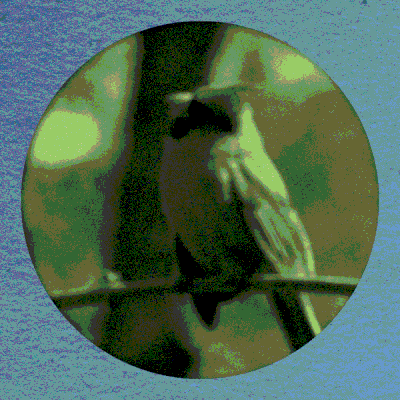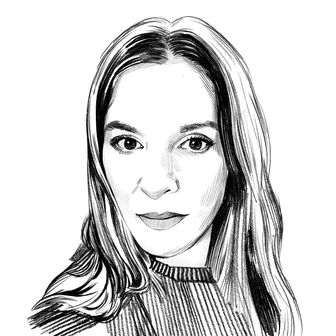
Once you become a bird-watcher, you can never not be a bird-watcher — you see, it’s not so much a hobby as it is a lifestyle. And yes, I just wrote that sentence and know exactly how it sounds because it sounds that way to me too. But birds are everywhere all the time. And they move. If you want to see them, you have to be ready. And trust me, you want to see them. Each species has its own quirky behaviors, and the variety is endlessly amusing. Plus they’re gorgeous. Even birds that look matte black come alive in the sunlight, exploding with different colors.
Anyway, that was my thinking a few weeks ago when, at 8:47 a.m., in the middle of an unscheduled 16-hour layover, I unzipped my suitcase and laid it open on the asphalt of a parking lot in southern Florida. I should have been on hold with American Airlines; instead, I was looking for my Leica Noctivid binoculars, which I had packed in a protective wad of dirty laundry because they cost 33 times more than a room at the Miami International Airport Clarion Inn & Suites, where I had just spent the night. The flight could wait. I’d noticed some interesting ducks across the street.
The first time I started paying attention to birds was in 2015, during a mountaineering course in the North Cascades. I was lost in thought when I looked up and noticed our course leader jabbing his figure at a tree. “Did you see it?” he asked. Apparently, everyone had spotted some sort of special flycatcher. I tried to tell myself it wasn’t a big deal that I’d missed it, but I was annoyed. I didn’t even know what a flycatcher was, but I knew why I hadn’t seen it. A chronic forward-thinker, I was always planning and setting goals so I could check them off my mental to-do list. The concept of being present eluded me — and here was another example of my inability to live in the moment.
When I got back home, I decided I needed to see a flycatcher. So I joined a Brooklyn Bird Club walk in Prospect Park. The first thing I learned is you need binoculars. I hadn’t brought a pair because I saw birds all the time without them. But I quickly realized we weren’t going to be watching the birds I usually saw in the park like robins and pigeons. Those were common “residents,” one of the club members told me. We could see them anytime. It was May, the peak of spring migration, and we were looking for the birds that were here for only a few days before continuing their journeys north. The second thing I learned: Bird-watchers love offering up their knowledge to the uninformed, solicited or not.
I also realized there’s not a lot of watching. In fact, these people didn’t even call it bird-watching. They called it birding. They walked and listened, and every now and then, they’d swing their heads in unison. Then someone might raise their binoculars to look at something, and everyone else would raise theirs and look at the same spot. After they figured out what they were all looking at, they moved on. I saw nothing but leaves.
Eventually, another birder took pity on me and shared his binoculars. I was floored. There was a little orange-and-black guy that moved like a hyperactive toddler (the American redstart, he called it). A gray-and-yellow one with a goth superhero eye mask (the common yellowthroat, apparently). I’d never seen any of these birds! “You’re getting lots of lifers,” he said. Then, seeing my confusion, he explained that most birders keep a life list of all the birds they’ve ever seen, and whenever they add a new one, it’s called a lifer.
Making lists? Checking things off lists? All while being outdoors? This was a hobby I could get into. I found an old pair of binoculars, bought my first field guide, and kept tagging along on the club’s weekly walks. I quickly learned that birds never look like the illustrations in the guidebooks, which, I realized, was fine — a good thing, actually. If I was busy looking at a book, that meant I wasn’t paying attention to what was in front of me. I had to figure out how to turn off the internal noise and focus on being present. Where was I? Where was the bird? What was it doing? How did it move? Was the angle of the sunlight affecting its color? I could use all that information to narrow down the possibilities and then check the book later to try and confirm the species. The more I observed, the more I learned.
By 2020, I could identify most of the bird families in New York State, including the flycatchers. I upgraded my binoculars and started getting into the apps. Audubon has an ID function that lets you plug in things such as size, color, and habitat to get a list of possible birds. That was super-helpful for learning the specific species within the families. I also downloaded eBird to make checklists whenever I went birding and to maintain a life list of my own. And last year, the Merlin birding app added a function called “Sound ID,” which is sort of like Shazam for bird calls. That really upped my game. If I saw a bird I thought I could identify, I’d wait for it to make noise and use the Sound ID to confirm my guess. Pretty soon I was able to identify a bunch of birds by their calls alone. I didn’t even need to leave my house to go birding — I could lean out my window, listen to the hum, and bird by ear.
These days, I bring my binoculars everywhere, and I’m not shy about pulling them out if I see something interesting. “ABB,” I tell my friends when they roll their eyes. “Always be birding.” It’s taught me to stay calm and present and to stop worrying about the future — something that comes in handy when, say, your flight has been canceled and you’re standing in a hot parking lot.
Binoculars located, I put the thought of rebooking my flight on hold and steadied my breath to focus on the ducks. They had waddled onto the grass of a garden-apartment complex about a hundred yards away. Black and white feathers. Long necks. Red bumps on their faces. I pulled out my phone, opened up eBird, and added a sighting: “Muscovy duck (established feral).” A lifer — number 305 on my list.
More From This Series
- I Make Ceramics to Keep My Hands Busy
- I Need to Be a Wine Person
- Pole Dancing Helped Me Regain Control of My Life





